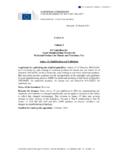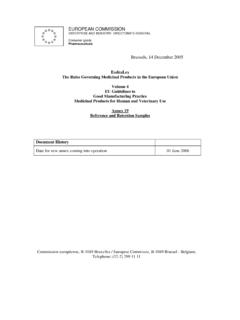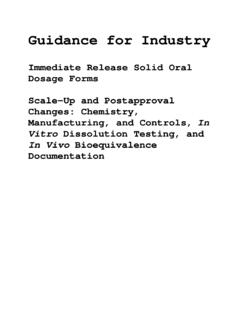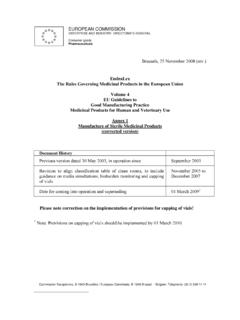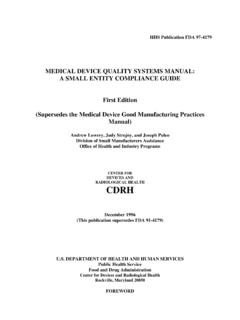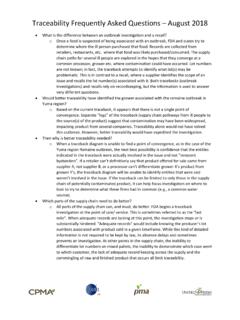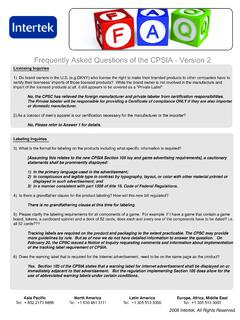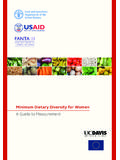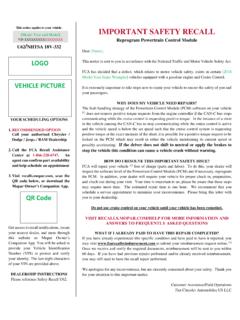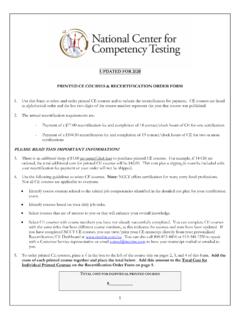Transcription of VERSION 1 - Trends
1 Commission europ enne/Europese Commissie, 1049 Bruxelles/Brussel, BELGIQUE/BELGI - Tel. +32 22991111 Office: DM24 02/28 - Tel. direct line +32 229-54122 - Fax +32 229-81287 EUROPEAN COMMISSION HEALTH AND CONSUMERS DIRECTORATE-GENERAL Health systems and products Medicinal products quality, safety and efficacy Brussels, GOOD DISTRIBUTION PRACTICE FOR MEDICINAL PRODUCTS FOR HUMAN USE QUESTIONS AND ANSWERS VERSION Document history: Date of submission of draft to the Pharmaceutical Committee:1 13 November 2013 Date of publication: See above Date of entry into force: N/A Supersedes: N/A Changes compared to superseded VERSION : N/A Important notice: The views expressed in this questions and answers document are not legally binding. Ultimately, only the European Court of Justice can give an authoritative interpretation of Union law.
2 This documents sets out frequently-asked 'questions and answers' regarding the new guidelines on Good Distribution Practice of medicinal products for human applicable as of 8 September 20132, and their revision of November 20133. 1 2 Guidelines of 7 March 2013 on Good Distribution Practice of Medicinal Products for Human Use, OJ C 68, , p. 1. 3 Guidelines of 5 November 2013 on Good Distribution Practice of Medicinal Products for Human Use, OJ C 343, , p. 1. Ref. Ares(2014)968163 - 28/03/20142 1. QUESTION: IN CHAPTER 2 PERSONNEL, (1), WHAT IS THE DEFINITION OF COMPETENT ? Answer: Having the necessary experience and/or training to adequately perform the job. 2. QUESTION: CONCERNING CHAPTER 2 PERSONNEL, (1), IS IT POSSIBLE TO EMPLOY STAFF STARTING THEIR PROFESSIONAL CAREER? Answer: Yes, if you properly training them before assigning them to their tasks.
3 3. QUESTION: IN CHAPTER 2 PERSONNEL, (5), WHAT IS MEANT BY PERIODICALLY ASSESSED ? Answer: Assessed at regular intervals. The timing of intervals is left flexible, without prejudice to national legislation. 4. QUESTION: IN CHAPTER 2 PERSONNEL, , DOES THE STATEMENT "APPROPRIATE PROCEDURES RELATING TO PERSONNEL HYGIENE, RELEVANT TO THE ACTIVITIES BEING CARRIED OUT, SHOULD BE ESTABLISHED AND OBSERVED" REFER TO THE HEALTH AND/OR CLEANLINESS OF THE STAFF? Answer: It only refers to the cleanliness of the staff, so to avoid any alteration of the product. 5. QUESTION: IN CHAPTER 3 PREMISES AND EQUIPMENT, (3), IS THE INTENT OF SEGREGATION TO AVOID CROSS-CONTAMINATION AS MENTIONED IN CHAPTER 5? Answer: The intent of this provision is to avoid handling errors and accidental swaps of products.
4 This is why electronic segregation is allowed, except for falsified, expired, recalled and rejected products which always have to be segregated physically. 6. QUESTION: CONCERNING CHAPTER 3 PREMISES AND EQUIPMENT, (7), IS THE LID OF A BOX / TOTE AN ADEQUATE PROTECTION AGAINST WEATHER CONDITIONS? Answer: Any tool protecting products from prevailing weather conditions is acceptable. 7. QUESTION: CONCERNING CHAPTER 3 PREMISES AND EQUIPMENT, , HOW MANY PROBES ARE NECESSARY TO MONITOR THE TEMPERATURE? Answer: The number of probes and their placement depend on the risk analysis performed on the site and the placement should be in agreement with the mapping results. 8. QUESTION: CONCERNING CHAPTER 3 PREMISES AND EQUIPMENT, (2), WHAT IS MEANT BY INITIAL TEMPERATURE MAPPING? Answer: An initial temperature mapping is an exercise in which temperature sensors are placed on the points identified as most critical through a risk analysis 3 ( at different heights, near a sunny window, next to the doors, etc.)
5 Once placed, a measurement is taken over a period of time and with the results obtained, the temperature sensors will be places where greater fluctuation occurred. The mapping should be performed in different seasons where highest and lowest temperatures are reached. 9. QUESTION: CONCERNING CHAPTER 3 PREMISES AND EQUIPMENT, (3), WHAT ARE APPROPRIATE SETTINGS FOR THE ALARM LEVELS? Answer: Alarm settings should be chosen as to guarantee a timely alert of personnel when there are excursions from predefined storage conditions 10. QUESTION: CONCERNING CHAPTER 3 PREMISES AND EQUIPMENT, (1), IS IT REQUIRED TO HAVE ONLY EQUIPMENT WITH A CE CERTIFICATE OF CONFORMITY? Answer: No. The CE marking is mandatory only for products dating from 1993 or later. It should be noted that the presence of a CE certificate of Conformity doesn t exempt from equipment validation/qualification.
6 11. QUESTION: CONCERNING CHAPTER 3 PREMISES AND EQUIPMENT, (1), IS IT REQUIRED TO RECORD ALL DEVIATIONS OR CAN THEY BE LIMITED TO SIGNIFICANT DEVIATIONS HAVING AN IMPACT ON PRODUCT SECURITY AND INTEGRITY? Answer: All deviations from established procedures should be documented. 12. QUESTION: CONCERNING CHAPTER 5 OPERATIONS, (3), ARE THERE ANY BEST PRACTICES FOR THE INVESTIGATION OF UNUSUAL SALES PATTERNS ? Answer: It is recommended to check for unusual repetition of orders, sudden increases of orders, and unusually low prices. 13. QUESTION: CONCERNING CHAPTER 5 OPERATIONS, (3), HOW CAN WHOLESALERS PROVE THAT THE MEDICINES THEY RECEIVE ARE RELEASED FOR SALE? Answer: The batches of medicinal products which have undergone the controls referred to in Art. 51 of Directive 2001/83/EC in a Member State are exempt from the controls if they are marketed in another Member State, accompanied by the control reports signed by the qualified person.
7 In other words, the batch arriving from another member state needs to be accompanied by evidence that the manufacturer s qualified person has certified the finished product batch for the target member state. The technical means by which this evidence is provided has been left to the discretion of the companies: a physical control report or an equivalent system of proof of release. 4 14. QUESTION: CONCERNING CHAPTER 5 OPERATIONS, (3), CAN THE PROVISION REQUIRING WHOLESALERS TO PROVE THAT THE MEDICINES THEY RECEIVE ARE RELEASED FOR SALE BE MADE APPLICABLE AS OF 2017, WHEN MEDICINAL PRODUCTS WILL CARRY SAFETY FEATURES THAT CAN BE CHECKED THROUGH A DATABASE? Answer: No, these provisions are already into operation as the new GDP guideline simply repeats what mentioned in Directive 2001/83/EC. 15. QUESTION: IN CHAPTER 5 OPERATIONS, (1), WHAT IS THE DEFINITION OF SEPARATELY ?
8 Answer: This provision refers to physical separation only in case of presence of other products likely to alter the medicinal product. Segregation is also necessary for falsified, expired, recalled and rejected medicines. In all other cases, electronic segregation is possible. 16. QUESTION: CONCERNING CHAPTER 5 OPERATIONS, (8), IN WHAT WAY SHOULD INVESTIGATION AND DOCUMENTATION BE DONE? Answer: Reasons for stock irregularities should be investigated and documented. 17. QUESTION: CONCERNING CHAPTER 6 COMPLAINTS, RETURNS, SUSPECTED FALSIFIED MEDICINAL PRODUCTS AND MEDICINAL PRODUCT RECALLS, (2)(I), HOW CAN WHOLESALERS VERIFY THAT A PACK HAS NOT BEEN OPENED IF IT DOES NOT CARRY AN ANTI-TAMPER DEVICE? Answer: The anti-tampering device will become compulsory in the coming years. Meanwhile, check to the best of your capacities whether the pack has signs of tampering.
9 18. QUESTION: CONCERNING CHAPTER 6 COMPLAINTS, RETURNS, SUSPECTED FALSIFIED MEDICINAL PRODUCTS AND MEDICINAL PRODUCT RECALLS, (2)(III), HOW SHOULD THE CUSTOMER DEMONSTRATE THAT THE MEDICINAL PRODUCTS HAVE BEEN TRANSPORTED, STORED AND HANDLED IN COMPLIANCE WITH SPECIFIC STORAGE REQUIREMENTS? Answer: The customer needs to provide papers showing that the medicinal products have been transported, stored and handled in compliance with their specific storage requirements. 19. QUESTION: CONCERNING CHAPTER 6 COMPLAINTS, RETURNS, SUSPECTED FALSIFIED MEDICINAL PRODUCTS AND MEDICINAL PRODUCT RECALLS, (3), WHAT SHOULD THE DOCUMENTED EVIDENCE CONTAIN TO BE REGARDED AS SUFFICIENT? Answer: The evidence should cover: (i) delivery to customer; (ii) examination of the product; (iii) opening of the transport packaging; (iv) return of the product to the packaging; (v) collection and return to the distributor; 5 (vi) return to the distribution site refrigerator.
10 20. QUESTION: IN CHAPTER 6 COMPLAINTS, RETURNS, SUSPECTED FALSIFIED MEDICINAL PRODUCTS AND MEDICINAL PRODUCT RECALLS, (3)(IV), DOES THE TERM "PACKAGING" REFER TO THE TRANSPORT BOX? Answer: Yes 21. QUESTION: IN CHAPTER 6 COMPLAINTS, RETURNS, SUSPECTED FALSIFIED MEDICINAL PRODUCTS AND MEDICINAL PRODUCT RECALLS, (6), WHAT DOES IT MEAN TO RECORD THE PROGRESS OF THE recall ? Answer: You need to record the status of the recall and whether it was successful or not. 22. QUESTION: CONCERNING CHAPTER 9 TRANSPORTATION, (1), CAN WE DEVIATE FROM STORAGE CONDITIONS IF THE MANUFACTURER AGREES TO THE TRANSPORTATION OF THE PRODUCT WITHIN A CERTAIN TEMPERATURE RANGE (2 -25 C) FOR A LIMITED TIME FRAME OF 6 HOURS? Answer: No. Storage temperature limits as described by the manufacturer or on the outer packaging need to be respected for each stage of transport during the whole transport chain.

